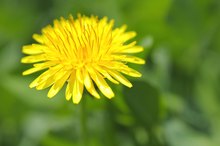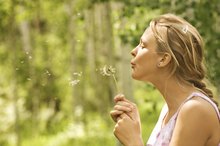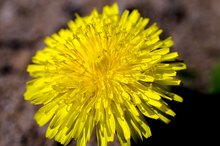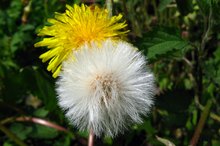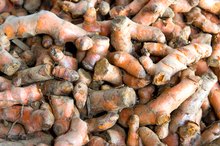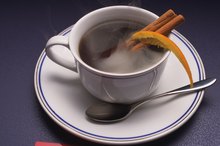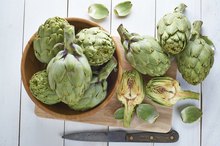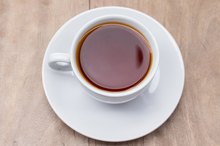Chicory Root Vs. Dandelion Root
The chicory plant is indigenous to Europe, India and Egypt and was introduced to the United States in the late 19th century. The dandelion plant grows wild in most parts of the world and is cultivated in France and Germany 3. The roots of both plants purportedly have therapeutic properties. Seek the advice of your doctor before you use any botanical herbs.
If you are experiencing serious medical symptoms, seek emergency treatment immediately.
History
Native Americans used dandelion root infusions to treat stomach problems, kidney disease, heartburn, swelling and skin problems 3. In Europe, dandelion root was incorporated into remedies for boils, eye problems, fever and diarrhea 3. Chicory was cultivated in Egypt as a medicinal herb about 5,000 years ago. Early European herbalists believed chicory had a stimulating effect on the liver. Chicory root was used as a coffee substitute and additive in Europe in the 19th century.
- Native Americans used dandelion root infusions to treat stomach problems, kidney disease, heartburn, swelling and skin problems 3.
- Chicory root was used as a coffee substitute and additive in Europe in the 19th century.
Properties
Herbs That Remove Ascites in the Abdomen
Learn More
The dandelion plant is rich in vitamins and minerals 3. It contains beta-carotene, thiamine, riboflavin, and vitamins C and D. Minerals include:
- potassium
- iron
- calcium
- magnesium
- phosphorus
- sodium
Dandelion also contains fiber, and linoleic and linolenic fatty acids 3. Chicory does not contain as wide a variety of nutrients. Chicory contains the fiber inulin, carbohydrates and flavonoids. When roasted, inulin provides a coffee-like aroma.
- The dandelion plant is rich in vitamins and minerals 3.
- Chicory contains the fiber inulin, carbohydrates and flavonoids.
Present-Day Applications
Tea made from dandelion root can be used as a diuretic, to aid liver and gallbladder function, to regulate blood sugar and to stimulate appetite, according to the University of Maryland Medical Center 13. Chicory can also be used as an appetite stimulant. Oligosaccharides in chicory have probiotic properties and help maintain beneficial bacteria in the gastrointestinal tract. The presence of the fiber inulin may help chicory treat constipation, diarrhea and cardiovascular disease, notes Drugs.com 23. Dandelion and chicory roots can both be used as coffee substitutes 3.
Safety
What Are Dandelion & Burdock?
Learn More
Dandelion has not been evaluated by the FDA for purity or effectiveness, nor are there any regulated manufacturing standards 3. According to Drugs.com, some dandelion supplements have been found to be contaminated by heavy metals and other drugs 3. Do not take dandelion if you have gallbladder problems, are diabetic, or taking diuretics or blood thinners such as warfarin 3. Chicory is classified as safe by the FDA. However, Drugs.com suggest you avoid chicory if pregnant, breast feeding or if suffering from gallstones 23.
Related Articles
References
- University of Maryland Medical Center: Dandelion
- Drugs.com: Uses of Chicory
- Drugs.com: Dandelion
- Clare B, Conroy R, Spelman K. The Diuretic Effect in Human Subjects of an Extract of Taraxacum officinale Folium over a Single Day. J Altern Complement Med. 2009;5(8):929-34. doi:10.1089/acm.2008.0152
- Yang Y, Li S. Dandelion Extracts Protect Human Skin Fibroblasts from UVB Damage and Cellular Senescence. Oxid Med Cell Longev. 2015;2015:619560. doi:10.1155/2015/619560
- Rasmussen A, Jacob SE. Dandelion: An Important Allergen in Atopic Children. Dermatitis. 2017;28(2):166. doi:10.1097/DER.0000000000000262
- Wirngo F, Lambert M, Jeppesen P. The Physiological Effects of Dandelion (Taraxacum Officinale) in Type 2 Diabetes. Rev Diabet Stud. 2016;13(2-3):113-31. doi:10.1900/RDS.2016.13.113
- Cai L, Wan D, Yi F, Luan L. Purification, Preliminary Characterization and Hepatoprotective Effects of Polysaccharides from Dandelion Root. Molecules. 2017;22(9):1409. doi:10.3390/molecules22091409
- Ovadje P, Ammar S, Guerrero JA, Arnason JT, Pandey S. Dandelion root extract affects colorectal cancer proliferation and survival through the activation of multiple death signaling pathways. Oncotarget. 2016;7(45):73080-73100. doi:10.18632/oncotarget.11485
- Martinez M, Poirrier P, Chamy R, et al. Taraxacum officinale and related species-An ethnopharmacological review and its potential as a commercial medicinal plant. J Ethnopharmacol. 2015;169:244-262. doi:10.1016/j.jep.2015.03.067
- Jargin SV. Soy and phytoestrogens: possible side effects. Ger Med Sci. 2014;12:Doc18. doi:10.3205/000203
- American Botanical Council. Herbal Medicine: Expanded Commission E.
- Domitrović, R.; Jakovac, H.; Romić, Z. et al. Antifibrotic Activity of Taraxacum Officinale Root in Carbon Tetrachloride-induced Liver Damage in Mice. J Ethnopharmacol. 2010 Aug 9;130(3):569-77. doi:10.1016/j.jep.2010.05.046.
- You, Y.; Yoo, S.; Yoon, H. et al. In Vitro and In Vivo Hepatoprotective Effects of the Aqueous Extract From Taraxacum Officinale (Dandelion) Root Against Alcohol-Induced Oxidative Stress. Food Chem Toxicol. 2010 Jun;48(6):1632-7. doi:http://dx.doi.org/10.1016/j.fct.2010.03.037.
Resources
Writer Bio
Ollie Odebunmi's involvement in fitness as a trainer and gym owner dates back to 1983. He published his first book on teenage fitness in December 2012. Odebunmi is a black belt in taekwondo and holds a bachelor's degree in economics from Kingston University in the United Kingdom.
